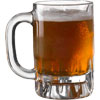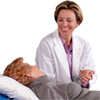Chronic pain
About pain
What is pain?
 | Pain is “an unpleasant sensory and emotional experience, associated with actual or potential tissue damage, or described in terms of such damage.” Pain can be classed by duration as acute or chronic and by source as nociceptive or neuropathic. |
For more information, see Pain.
Chronic pain syndrome
 | Chronic pain syndrome encompasses any pain that persists longer than the reasonable expected healing time for the involved tissues. The duration of pain is often arbitrarily set at 3 months. Chronic pain is not a symptom, but rather a disease state. |
For more information, see Chronic Pain Syndrome.
Complex regional pain syndrome type 1
 | Complex regional pain syndrome (type 1) or reflex sympathetic dystrophy syndrome/Sudeck’s atrophy involves a disturbance in the sympathetic nervous system where there is pain, as well as swelling and disability (often after injury) associated with other signs of sympatethic nerve dysfunction (initially warm and dry, and later cold and moist skin) in the affected area. |
For more information, see Complex Regional Pain Syndrome Type 1 (Sudeck’s Atrophy, Reflex Sympathetic Dystrophy).
Complex regional pain syndrome type2
 | Complex regional pain syndrome (type 2) or causalgia is a chronic pain condition seen after the section (damage, cutting) of a nerve. It is characterised by a chronic burning pain and hypersensitivity in the area supplied by that nerve. The sympathetic nerve supply of the involved area is believed to be important in the cause of this condition. |
For more information, see Complex Regional Pain Syndrome Type 2 (Causalgia).
Living with pain
Obesity and pain
 | There now appears to be a strong link between obesity and pain. Studies show that obese people are much more likely to feel light to intense pain in many parts of the body. Scientists do not understand exactly how or why obesity causes pain, but it is clear that weight loss can help reduce pain and improve quality of life for obese patients. |
For more information, see Obesity and Pain.
Pain and nutrition
 | There is a strong relationship between pain and nutrition. Recent studies have shown that pain is related to a disturbance of functions within our cells. Areas of importance include omega 3 essential fatty acids and antioxidants. Glucosamine and/or chondroitin in the management of osteoarthritis is another area of interest. Excessive body weight can also worsen some types of persistent pain. |
Pain and stress
 | Pain and stress are closely connected in many ways. Stress is the body’s physical response when it is put under a lot of pressure and called upon to make many changes. Symptoms of stress include; increased pain, fatigue, low mood, difficulty sleeping and changes appetite. Stress is unavoidable and experienced by everyone alike. However for people who are suffering from ongoing pain, stress often has a greater impact. |
For more information, see Pain and Stress.
Pain and sexuality
 | Sexuality is an important and sensitive issue that must be addressed in chronic pain sufferers. In people who suffer from pain, it is common for them to experience problems in their sexual functioning. This can result in much psychological distress and contribute to problems such as low self-esteem and depression. Pain can result in partners having decreased sexual desires and also difficulties performing during sex. |
For more information, see endocrine system.
Pain and alcohol
 | Treatment of pain has been an important issue in all medical systems. For many years, analgesic substances have been intensively studied and sought out. Alcohol was amongst one of the earliest substances found to be effective. In everyday life, many people continue to deal with pain by self-medicating with alcohol. Alcohol is a depressant that produces somnolence and decreased neuronal activity. |
For more information, see Pain and Alcohol.
Pain and physical activity
 | Many people with long standing pain become inactive and don’t do much exercise. Unfortunately, low activity levels lead to muscles becoming weak and wasting away, joint stiffness, weight gain and low mood. These factors can all contribute to worsening pain. There are many benefits of regular physical activity in reducing pain. |
For more information, see Pain and Physical Activity.
Treating pain
Treating chronic non-cancer pain
 | Before a doctor can treat someone for chronic pain, it is important that they ask some questions so that they can work out the best course of treatment. Some of the things they may want to know are whether the pain is the primary problem, what type of pain it is, how bad it is, what are the symptoms and causes of the pain, how the pain is impacting your life and if there is anything else that is making the pain worse. |
For more information, see Treating Chronic Non-Cancer Pain.
Paediatric pain management
 | Pain can be associated with numerous paediatric diseases and conditions and is an important consideration in children undergoing procedures and surgery. Control of pain in children can be quite difficult as it hard to determine the exact level of pain present. In addition, many of the medications used to treat pain have not been appropriately tested in children so doctors may not be entirely sure of their effects and be reluctant to use them. |
For more information, see Paediatric Pain Management.
Corticosteroids for pain relief
 | Corticosteroids are synthetic versions of naturally occurring adrenocortical steroids, which are produced by the adrenal glands. They have both anti-inflammatory and salt-retaining properties. Corticosteroids are often used as an adjunct to analgesics to treat pain, including cancer and non-cancer pain. Corticosteroids reduce inflammation and they are therefore useful in treating pain where inflammation or oedema is causing symptoms. |
For more information, see Corticosteroids for Pain Relief.
Simple analgesia
 | Simple or non-opioid analgesics are a diverse group of drugs that include anti-inflammatory drugs (non-steroidal anti-inflammatory drugs or NSAIDs) and paracetamol. Most anti-inflammatory drugs also have the ability to relieve fever and antiplatelet (anti-clotting) properties. Paracetamol is the preferred option for fever and mild-to-moderate pain as it has fewer adverse effects. |
For more information, see Simple analgesia.
Opiods for pain relief
 | Opioids are strong analgesics used in the relief of pain, both acute and chronic, and cancer and non-cancer. They are effective in nociceptive pain, and may be effective in neuropathic and inflammatory pain depending on the drug choice, dose and route. If used for long periods of time, opioids can be addictive. |
For more information, see Opoids for Pain Relief.
Introduction to neurostimulation
 | Neurostimulation has been used for the past 50 years. However its use has been increasing in recent times due to new exciting technology that has been developed, as well as research revealing more potential uses for this form of treatment. Different types include spinal cord stimulation, peripheral nerve stimulation and intracranial (deep brain and motor cortex) stimulation. |
For more information, see Introduction to Neurostimulation.
Spinal cord stimulation (SCS)
 | Spinal cord stimulation is a type of neurostimulation. It is a procedure in which leads with strategically placed electrodes are inserted along the spinal cord, where they artificially stimulate the nerves supplying the painful areas. Spinal cord stimulation is most commonly used for the management of pain which is not due to cancer. |
For more information, see Spinal Cord Stimulation (SCS).
Transcutaneous electrical nerve stimulation (TENS) devices
 | TENS or transcutaneous electrical nerve stimulation devices are primarily used to treat various forms of pain including chronic musculoskeletal pain, pain that occurs following an operation or surgery, cancer pain, phantom limb pain and pain during childbirth. A TENS device works by passing a small electrical current across the skin. This procedure is completely painless. |
For more information, see Transcutaneous Electrical Nerve Stimulation (TENS) Devices.
Dates
Tags
Created by:

 Login
Login














